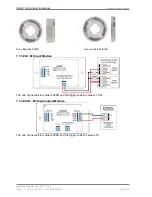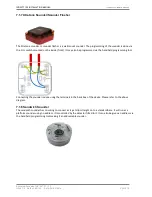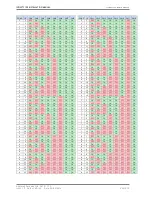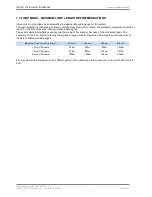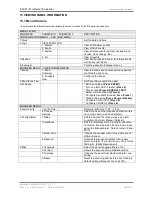
INFINITY ID2 INSTALLATION MANUAL.
Software Versions: PANEL 1.N & LOOP O.N
Approved Document No: GLT-211-7-1
Issue 1.9 Author: MG/NJ Date: 06/04/2016
PAGE 28
13 ALARM VERIFICATION
The ID2 includes an option to use alarm verification. It is intended for use in apartments, and similar buildings,
where it is desirable that an alarm from a smoke detector from one apartment (or area) would need to be
confirmed before the whole system goes into alarm.
13.1 Alarm Verification Options
The current revision of the panel (Software version 1.H or later) has 2 settings for alarm verification
Device verification. With this setting, an alarm will just operate the sounder connected to that detector.
Zonal verification. With this setting, an alarm will operate sounders connected to all sounders in that zone set to
Zonal verification. Zonal verification can also be set to heat detectors. But selecting this just allows the heat
detectors sounder to run on a verification from another detector. An alarm on that heat detector will set the
system straight into full alarm.
Advantages of Device verification
Allows for more "verification" areas per zone
Advantages of Zonal verification
Will set off all sounders for apartments with multiple
detectors
Note that both types of verification can be set on a zone at the same time if required
13.1 How Alarm Verification Works
The verification function works as follows:-
1.
Any SMOKE detector on the system can be set to verify an alarm. (Not that an opto-heat detecor is
treated as a smoke detector for verification, whether the alarm is caused by smoke or heat)
2.
If a detector with the verification setting senses smoke, the detector alarm LED will turn on. If the
detector has an associated sounder base, the sounder will turn on with the Alert tone (i.e. pulsed) rather
than the Evacuate tone. The ID2 panel`s screen will show “Confirming alarm”.
3.
If the device in alarm has zonal verification set, the panel will turn on the sounders of all other detectors
set to zonal verification in that zone.
4.
If the detector drops below the alarm level within the programmed verification time (1 minute to 3
minutes 45 seconds), the sounder will turn off, but the panel will continue displaying “Confirming Alarm”
for at least 5 minutes. The buzzer will also continue to operate as long as the “Confirming Alarm”
message is displayed.
5.
If the detector stays in alarm by the end of the verification delay, the system will go into full alarm.
6.
If another detector WITHOUT verification setting or a call point goes into alarm, the panel will go
straight into full alarm.
With this method of operation a “cooking alarm” in one apartment will alarm locally, giving the apartment
occupants a chance to clear the smoke before the whole building is evacuated. Also, as a “failsafe”, if a heat
detector alarms, or if a second smoke detector on the system goes into alarm, the system will go into full alarm.
13.2 Setting the Alarm Verification Delay
To set the verification delay, go to Configuration menu 2 and select option 6
System menu.
From the engineer menu 2, select option 4
From the Verification screen, select option 1 (Verify time)
Use Prev& Next to adjust the time, then press enter to confirm
13.3 Applying Alarm Verification Delay to a detector
To set the verification delay for a detector, go to Engineer menu 2 and select option 4
Alarm Verify. Then in the Verification menu select option 2 Choose Device.
Scroll to the required device, then press V for Verification. The letter V appears in the top
right hand corner to confirm that this device has a DEVICE verification delay. Pressing “V”
again will change the letter to Z for Zonal verification. Press V one more time to toggle the
Verification off.
Engineer Menu 2
4: Alarm Verify
5: Config Alarms
6: Misc
Detector Verify Time
1:30
ENTER to Confirm
Optical
V
Normal
Fl 3 Bedroom 303
Zone:01ID:011

